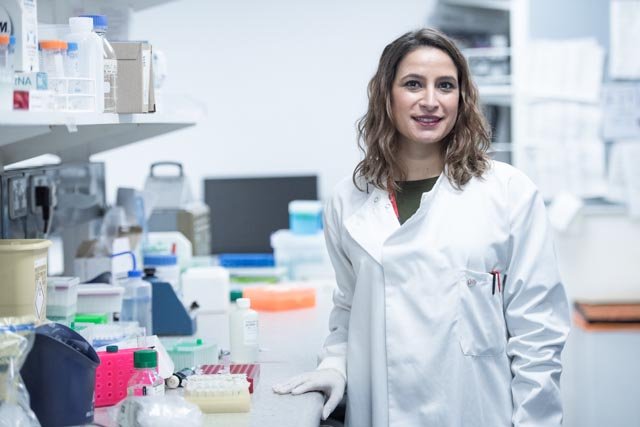Why is the Lily Exome Sequencing project so important?
Before this project existed, families affected by mitochondrial disease often had to wait months or even years to get a confirmed diagnosis. Genes were tested one at a time, and had to be sent off to specialised labs around the world. But by using exome sequencing technology we can look at thousands of genes simultaneously, which really speeds up the diagnostic process. Families are getting the answers they need much faster, and can make important life choices based on the results.
Can you describe your role on the project?
I'm a cell biologist specialising in mitochondria. It's my job to prepare patient DNA samples for sequencing and then go through all the data on each DNA variant to identify any causative genes. We now know over 300 genes where mitochondrial disease can occur, and we are discovering more all the time. We are also finding new DNA variants within some of those genes, which affect how the disease presents. This is important because it explains why two cases with the same causal gene might sometimes have very different clinical presentations.

What steps are involved in processing a DNA sample?
When we receive a sample it's just a tiny tube of what looks like water. First I put that into a little machine called a Qubit, which tells me the quantity and quality of the DNA in the sample. Once we have enough samples to make up a batch, I'll take them downstairs to the genomics facility, where sequencing is performed using the Illumina HiSeq machine. Data is then transferred to a supercomputer and run through our in-house analysis pipeline. It can take the supercomputer up to two days to run the analysis, but then we have information on each DNA sequence variant, such as which chromosome it sits on and the coordinates of its location. If it resides in a gene it will also tell us what type of variant it is, and whether it's causing a change in the structure of the protein.
What other skills do you need to do your job, besides cell biology?
I do a lot of computational work, which is something I've had to learn on the job. Each file has about 20,000 different variants, so I start working with a spreadsheet with 20,000 lines. I've built an automated program that narrows those down to a list of 300-400 plausible biological candidates, ranked according to their biological function and relevance. The next steps of the analysis involve a manual review of the data. This process may take a few hours or in some cases several days if the answer is not obvious. In these cases, if I still need more clues, I'll talk to the clinician on the case to get more information about the clinical presentation. For instance, if it's a neurological condition I would then focus my attention on genes that are known to have a neurological link.
What do you enjoy most about your work?
Sometimes families who have had their mitochondrial disease diagnosis confirmed will ask who found the gene, and we’ve been introduced. They’re always really grateful to have answers, because it allows them to consider potential treatments, apply for patient trials, and make important life choices such as family planning. It's about giving families affected by mitochondrial disease more control about the future. Most of us researchers pursue our work because we want to make people's lives better, but often we’re so isolated in our labs that we don't see the impact our work is having. So with the Lily project it’s been rewarding to meet the families involved, and see how our work is making a difference.
What's it like to work on a charity-funded project?
There's a real sense of family about The Lily Foundation, with everyone working for a common goal. The project isn't government-funded or owned by a corporation, so there's no private interest or competition over funding. Everyone is very keen to share research, because we know it's for a greater good. We are all working for the Lily Foundation, and that makes us more cohesive. When one of us discovers something it's a win for everyone. That makes a big difference for patients, because they have the best possible chance of getting a confirmed diagnosis for their mitochondrial disease, and also has positive implications for wider research in the field.
Is the project uncovering any new knowledge about mitochondrial disease?
Definitely. Since we started in 2014 we have identified 32 new disease-causing gene variants, and we're also adding to the information we have on the genes we already know about. Because we’re constantly learning, we never really consider any unsolved case to be closed; we keep all the data on file, so when we find new information we can go back and see if it sheds any new light on the diagnosis. So while we might not always be able to give families answers right away, it can be that a few months down the line we might have something.
Where do you see the project going next?
Thanks to Lily funding we've recently begun using a new, advanced sequencing technique called RNA Sequencing (RNA-Seq). This is a different way of analysing the gene, another level of interrogation that might reveal information not picked up by the direct analysis of patient’s DNA. All our currently unsolved cases will be sent for RNA-Seq, so we're hoping it could further increase our percentage of confirmed diagnoses. In this area of science things are changing fast, but there's a real drive to stay at the forefront and do all we can to help families affected by mitochondrial disease.

